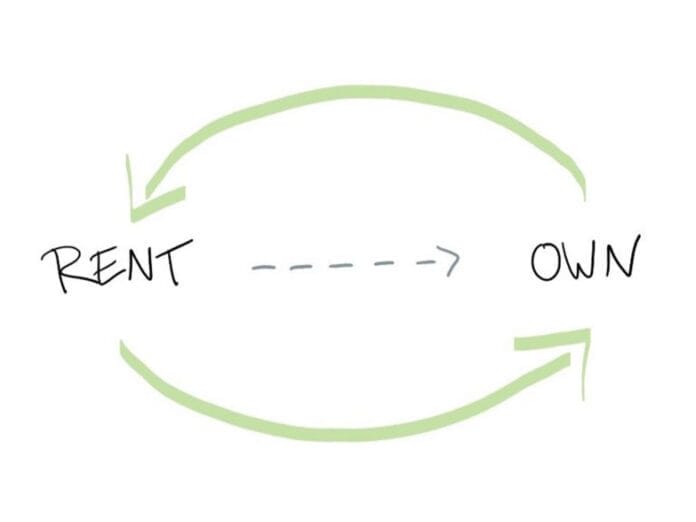
Build to Rent (BtR) is big, and rightly so, given the potential it has to play in the housing market. Owner occupation has declined since the turn of the century, currently hovering at around 63% of all households, and the BtR sector has expanded, meaning that around 20% of UK households now live in a rented property. If this trend continues at the same rate, by 2040 the majority of us will be renting.
The significance of BtR has also now been officially recognised on a governmental level – the 2018 update to the National Planning Policy Framework classified BtR as a form of housebuilding for the first time. Alongside the level of growth and investment in BtR, it is the emerging new typologies and innovation in the sector that makes it particularly fascinating. However, what does all this mean and how does BtR fit into the bigger picture of the UK housing sector.
The Chain Reaction
Simplifying the housing sector right down – what we essentially have are two component parts, existing housing stock and new build property; all in a context of increasing urbanisation and densification, putting pressure on available land and resources. As a starting point, the questions we should be asking are:
- How do we use what we already have to the maximum effect; and,
- Are we actually building the right kind of new stock?
Whilst it is not really possible to answer either of these questions in any detail here, or any other outlet without a considerable amount of research and thinking, let’s consider a scenario where building the right kind of BtR product has the potential to catalyse a ‘chain reaction’ in the housing sector. In other words, a situation where BtR creates a meaningful link between the existing and the new, becoming an aspiration rather than a necessity. Imagining the ‘housing ladder’ as a parallel timeline to an individual’s career path, i.e. the typical scenario of higher education to retirement, we would end up with something like this:

By developing and building appropriate BtR products, we could achieve a more holistic, circular housing environment:

Linking the ‘opposite ends’ of the housing timeline in this circular manner could result in releasing existing housing stock back to the market, providing much needed family homes which can otherwise often be compromised and/or difficult to deliver in more urban, high density settings.
Recognising (and ignoring) the fact that all of this so far requires a significant amount of generalisation and guesswork, these are the kinds of conversations we should nevertheless be having when it comes to housing – looking for links, overlaps, similarities and opportunities.
For instance, when stripping away the finer detail, a purpose-built student accommodation (PBSA) scheme is not much different to one built for retirement living (RL). The fundamental principles are the same – both buildings need to provide particular types of amenity facilities with the aim of fostering a sense of community. In a time where the availability of developable land is under increasing pressure, we should be looking to maximise all opportunities for mixed-use, mixed tenure, mixed everything. In this case (PBSA vs. RL), rather than mixed-use in terms of variation of function, we are looking at a single function building which appeals to a multitude of users – a BtR product with multi-generational appeal.
Generalisations aside, the key message to take away here is that we must start thinking and acting in a more joined up, holistic manner when it comes to the housing sector and its various components.
What is stopping us?
Amongst the multitude of obstacles that come to mind when considering a more holistic approach to housing, two challenges seem key – the need to collaborate and the lack of a suitable framework.
In terms of the former, there is currently perhaps not enough collaboration happening between different BtR providers and developers. This is important, particularly when it comes to the newer BtR products, which tend to seek a reduction in space standards and other policy requirements in return for more flexibility and social, community-enhancing elements. What seems to happen more often than not is that each different brand or product is presented in isolation to local planning authorities, putting forward a variation on a theme rather than a strong, coherent case for BtR as a whole. Whilst from a commercial perspective, this might be initially beneficial, the individual approach can lead to frustration and mistrust within local authorities. Protecting brand identity is certainly a key consideration. However, failing to obtain planning consent for not presenting a case for the bigger picture is surely the greater concern.
The issue of collaboration could possibly be resolved through a legislative framework that supports and promotes BtR in its various forms, clarifying and strengthening its purpose within the housing sector. The outlook is (cautiously) positive with BtR officially recognised within the NPPF (July 2018) and the Greater London Authority, via the draft London Plan, also lending support. However, this is just the beginning and there is a long way to go – we are up against restrictive space standards and use classes within a slow-moving planning policy environment and are not yet in a position to operate in a truly joined-up, circular housing sector.
So, what are we going to do about it? Can we, the future generation of this industry start a meaningful debate, which gathers momentum and leads to positive decisions being made that support a circular housing sector? I say we try!